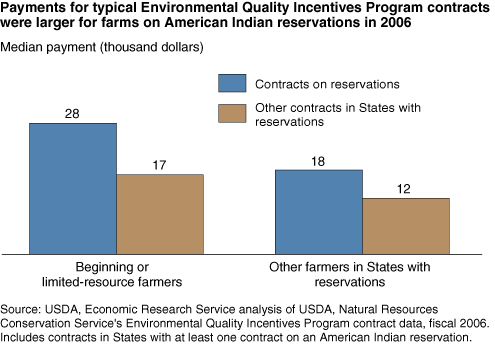Fewer Farms on Reservations Join Conservation Program, But Make Larger Conservation Investments
- by Michael S. Hand
- 3/1/2010
American Indian reservation communities tend to have higher poverty rates, lower health status, and greater food insecurity than other areas of the United States. While conservation programs do not directly address these socio-economic conditions, they can affect community-wide quality of life through their environmental impacts.
USDA’s Environmental Quality Incentives Program (EQIP) funds a variety of conservation practices on working farmland that may provide nearby communities with environmental benefits resulting from reduced sedimentation and nutrient runoff in streams and rivers, improved air quality, and more abundant fish and wildlife habitats.
According to ERS research, farms on reservations are less likely to participate in EQIP than farms elsewhere. In States that contain American Indian reservations, about 4 percent of EQIP contracts and 6 percent of funding in 2006 went to farms on reservations. Reservation farms account for 9 percent of all farms and 8 percent of farmland in these States, but it is not known whether EQIP contracts on reservations are actually held by reservation residents.
Participating reservation farms, however, do tend to have larger EQIP contracts than other farms. The median payment for contracts on reservations exceeds contracts on other farms in States with reservations by $6,000 to $11,000. Larger contracts can translate into additional conservation practices, larger scale projects, and greater environmental benefits per contract.
The higher contract payments on reservations are partially due to their greater numbers of beginning and limited-resource farmers, who generally receive higher cost-sharing rates than other participants. However, a comparison of contract payments for only beginning and limited-resource farmers reveals that typical contract payments are still larger on reservations. Further, the size of fences and pipelines built with EQIP funds on reservation farms confirms that contracts on reservations involve bigger investments, not just higher cost-share rates.
Farms on reservations tend to be smaller than other farms in States with reservations. This suggests that other differences, such as environmental issues addressed with EQIP contracts, may account for the larger contracts on reservations. Reservation contracts are less likely to address soil erosion and water quality problems and are more likely to be used to improve the conditions of forage plants and animals by adopting managed grazing and installing watering facilities.
Contracts on reservation farms are also less likely to be associated with cropland that has been designated as highly erodible. These contracts may reflect other types of resource problems being addressed on reservations. Differences in environmental characteristics, conservation practice choices, and size of investment determine the environmental benefits that accrue to American Indian reservation communities from EQIP and have implications for how conservation programs serve reservation communities.
This article is drawn from:
- Nickerson, C. & Hand, M.S. (2009). Participation in Conservation Programs by Targeted Farmers: Beginning, Limited-Resource, and Socially Disadvantaged Operators' Enrollment Trends. U.S. Department of Agriculture, Economic Research Service. EIB-62.
We’d welcome your feedback!
Would you be willing to answer a few quick questions about your experience?


